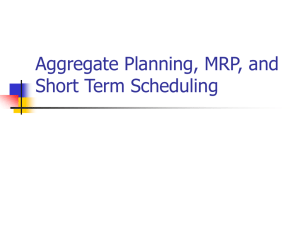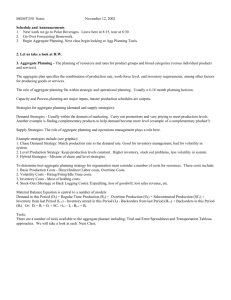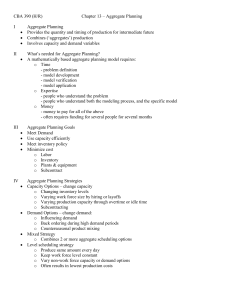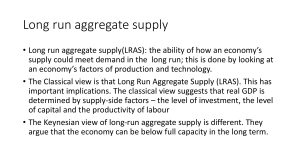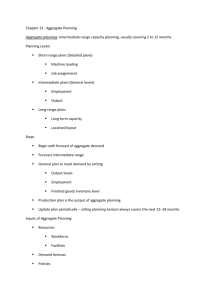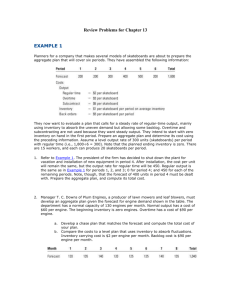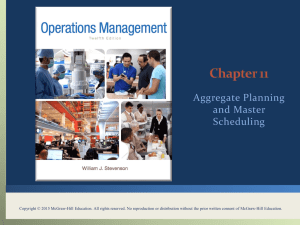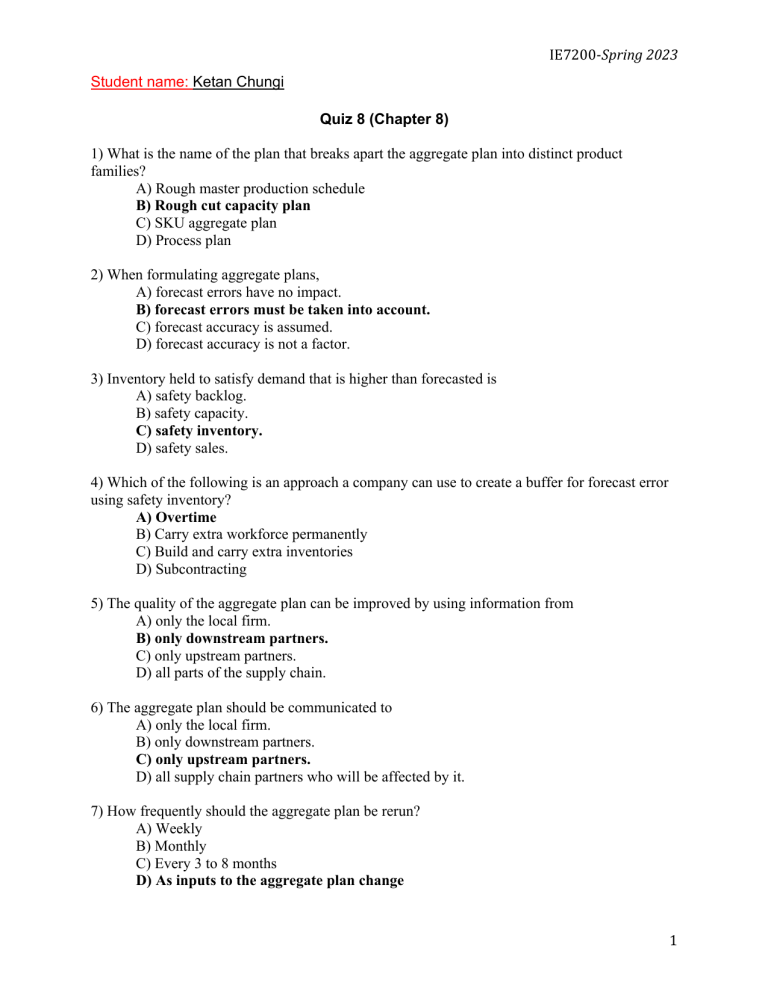
IE7200-Spring 2023 Student name: Ketan Chungi Quiz 8 (Chapter 8) 1) What is the name of the plan that breaks apart the aggregate plan into distinct product families? A) Rough master production schedule B) Rough cut capacity plan C) SKU aggregate plan D) Process plan 2) When formulating aggregate plans, A) forecast errors have no impact. B) forecast errors must be taken into account. C) forecast accuracy is assumed. D) forecast accuracy is not a factor. 3) Inventory held to satisfy demand that is higher than forecasted is A) safety backlog. B) safety capacity. C) safety inventory. D) safety sales. 4) Which of the following is an approach a company can use to create a buffer for forecast error using safety inventory? A) Overtime B) Carry extra workforce permanently C) Build and carry extra inventories D) Subcontracting 5) The quality of the aggregate plan can be improved by using information from A) only the local firm. B) only downstream partners. C) only upstream partners. D) all parts of the supply chain. 6) The aggregate plan should be communicated to A) only the local firm. B) only downstream partners. C) only upstream partners. D) all supply chain partners who will be affected by it. 7) How frequently should the aggregate plan be rerun? A) Weekly B) Monthly C) Every 3 to 8 months D) As inputs to the aggregate plan change 1 IE7200-Spring 2023 8) Aggregate planning solves problems involving A) aggregate decisions and stock keeping unit (SKU) level decisions. B) aggregate decisions or stock keeping unit (SKU) level decisions. C) aggregate decisions rather than stock keeping unit (SKU) level decisions. D) stock keeping unit (SKU) level decisions rather than aggregate decisions. 9) Much of aggregate planning has traditionally been focused A) on short-term production scheduling. B) on customer relationship management. C) within an enterprise. D) beyond enterprise boundaries. 10) The operational parameter concerned with the number of workers/units of capacity needed for production is A) production rate. B) workforce. C) overtime. D) backlog. 11) Aggregate planning is concerned with determining A) the production level, sales level, and capacity for each period. B) the demand level, inventory level, and capacity for each period. C) the production level, inventory level, and capacity for each period. D) the production level, forecast errors, and capacity for each period. 12) The length of the planning horizon in aggregate planning is usually between A) one and three months. B) three and eighteen months. C) one and three years. D) three and five years. 13) Aggregate planning should consider information from A) only the enterprise as its breadth of scope. B) downstream partners to produce forecasts. C) upstream partners to determine constraints. D) all of the above 14) The strategy where the production rate is synchronized with the demand rate by varying machine capacity or hiring and laying off employees as the demand rate varies is the A) adjustable strategy. B) chase strategy. C) level strategy. D) mixed strategy. 15) The strategy where a stable machine capacity and workforce are maintained with a constant output rate, with inventory levels fluctuating over time, is the A) adjustable strategy. B) chase strategy. C) level strategy. 2 IE7200-Spring 2023 D) mixed strategy. 16) Demand is forecast for the next five months as 200, 300, 500, 300, 200. The production planner decides to adopt a chase strategy, so over the next five months they should produce A) 200, 300, 500, 300, 200. B) 500, 400, 300, 200, 100. C) 100, 200, 300, 400, 500. D) 300, 300, 300, 300, 300. 17) A highly effective tool for a company to use when it tries to maximize profits while being subjected to a series of constraints is A) aggregate programming. B) distribution programming. C) production programming. D) linear programming. 18) One drawback of advanced planning systems is that A) a small change in input data can result in radically different production plans. B) the amount of computing power necessary requires a substantial source of electricity. C) the amount of computing power requires significant cloud storage. D) the technical expertise to operate most systems requires an advanced degree. 19) The success of advanced planning systems is highly dependent on A) access to the cloud. B) operating system. C) data quality. D) power structure. Case: Husky Tools (questions 20-25) Husky Tools, a manufacturing company, faces the aggregate planning problem shown in the table below. Cost of regular production is $5 per unit, the cost of producing the same unit on overtime is $7.50, the cost of subcontracting is $9 per unit, and the cost of carrying a unit in inventory from one month to the next is $2. Forecast Beginning Inventory Regular Time Overtime Subcontracting Ending Inventory January 500 100 February 750 March 1200 April 650 May 300 The labor contract at the plant prohibits both overtime and subcontracting output to exceed 300 units in any five-month window. The plant capacity is 600 units per month produced using two shifts, regardless of the number of days in a month. By policy, management wants to avoid stockouts. 20) Determine the number of decision variables in this scenario. 3 IE7200-Spring 2023 A) 10 B) 15 C) 20 D) 24 21) Determine the number of constraints in this scenario. A) 12 B) 15 C) 20 D) 24 22) Determine the objective function for this scenario. A) Max Output = + + B) Max Profit = - $5 - $7.5 - $9 - $2 C) Min Cost = $5 + $7.5 D) Min Output = + $9 + $2 + 23) Which of these is a constraint that is appropriate for the above case? A) ≥ 680 B) ≤0 C) + D) ≤ 300 ≤ 300 24) Which of these statements about Husky Tools is evident without even developing an aggregate plan? A) Some overtime will be needed. B) Ending inventory must be negative. C) Overtime must exceed subcontracting. D) Subcontracting must exceed regular time output. 25) What is the optimal total cost of the aggregate plan developed to address Husky Tools problem? A) $16,700 B) $18,950 C) $18,450 D) $16,250 4
